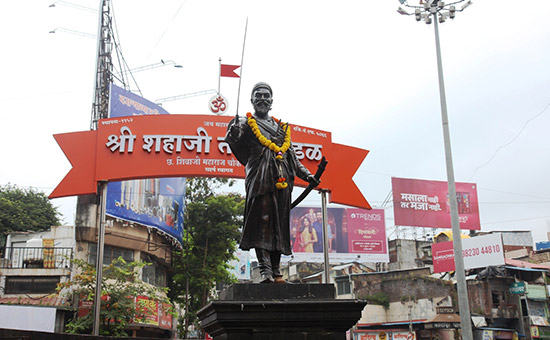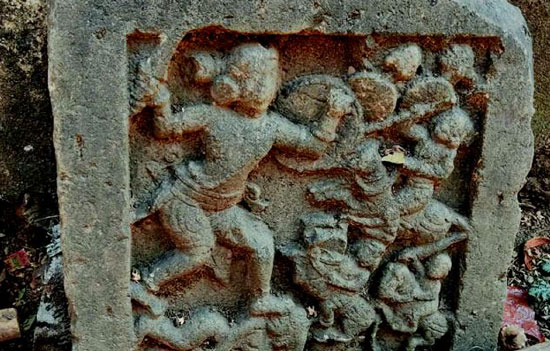- Read about Queen Mallama’s, of Belawadi Karnataka, encounter with the Marathas and sculpture she made in honour of Shivaji. India has many warrior queens.
Ancient
sculptures are not just objects of yore. They have numerous stories to tell if
only we are willing to listen. Yadwad, a village about 10 km from Dharwad,
Karnataka, has one such prized possession. It is a sculpture of Chhatrapati
Shivaji Maharaj. One may wonder what is unique about it as memorials of the
legendary Maratha warrior are strewn all across India. Strange as it may
appear, this sculpture put up in the Hanuman temple of this village is the only
surviving image of Shivaji made during his lifetime. Furthermore, this
archaeological object has played a decisive role in honouring a fantastic
episode that took place in the 17th century involving Belawadi Mallamma, a
Kannadiga brave heart queen and her foe-turned-friend Shivaji.
People
in this part of Karnataka firmly believe in this legend, which came to pass in
January 1678. How mischief played by a few Maratha soldiers led to hostility
between Shivaji and his admirer royale, the resulting conflict which caught the
attention of the nation during those days and how it eventually led to
reconciliation, makes for interesting reading.
First
published in Journal of Bharatiya Vidya Bhawan.
Belawadi was a small kingdom. Its territory was spread over parts of today’s Belagavi and Dharwad districts. The early Kannada work Tharaturi Panchamara Itihasa by Shivabasava Shastri traces the history of this principality to 1511 when its first ruler Chandrashekhara Raja started out as a vassal of the Vijayanagara Empire. After the fall of Vijayanagara, it became an independent principality. By the 17th century, it prospered under the rule of Ishaprabhu Desai and his consort Mallamma, who competently assisted him.
Queen Mallamma, who is still revered for her bravery, was the daughter of Madhulinga Nayaka, the ruler of Sonde kingdom, which had its sway over today’s Uttara Kannada district and south Goa.
Given
the turbulent political situation of those days, every other kingdom had to
keep its gunpowder dry. The need of the hour was such that, when the menfolk
went to battle, the women had to be ready as the second line of defence. Hence,
both boys and girls of the royal families were trained in the fine arts as well
as in warfare. This is the reason why we see most of the legendary women
warriors emerging on the scene during this span of time. The Sonde king arranged
for the training of Mallamma along with her brothers under an eminent teacher
Shankar Bhatt. Young Mallamma proved her mettle. She was good in horse riding,
javelin throw, fencing and archery.
By
the time she made it to the Belawadi royal household, she was well versed in
both matters of administration and military skill.
Upon
Mallamma attaining marriageable age, her father arranged for a Swayamvara (the ritual of girl choosing the husband rather than the other way round). The aspiring groom had to prove his masculinity by hunting the number of tigers equal to his age plus one, within one month. Ishaprabhu, the 20-year-old prince of Belawadi met this challenge by hunting down 21 tigers within the stipulated time to take Mallamma as his bride. Ishaprabhu was a competent and benevolent ruler. He was supportive of Mallamma’s partaking in statecraft.
Apart
from rubbing shoulders with her husband in administration, Mallamma also
trained the womenfolk in the martial arts and raised a 5,000
strong army of women, a rare feat during those days. The kingdom was
prosperous under their rule.
This
was also the time when Shivaji was being hailed as the icon of Hindu
revivalism, after crowning himself as a political sovereign braving the mighty
Mughals and the Adil Shahis. After consolidating his position in the Deccan,
Shivaji set out on the southern anabasis in 1676 by raiding the enemy
territories of Khandesh, Ponda, Karwar, Kolhapur and Athani. In Hyderabad, he
concluded a treaty with Qutubshah of the Golkonda Sultanate wherein the latter
agreed to retract his alliance with Bijapur and jointly oppose the Mughals.
Then he moved towards Tamil Nadu and captured the Vellore and Gingi forts.
After settling the matter of the Tanjavur jagir, which was ruled by his half-brother
Venkoji in November 1677, Shivaji began the return journey.
Crossing the River Tungabhadra in January 1678, and passing through Koppal and Gadag, he reached Lakshmeshwar. The local principalities submitted to Shivaji without any resistance. Mid-January of 1678, Shivaji’s forces decided to take rest and camped at Yadwad village, thereby setting the stage for future events.
By this time, Shivaji’s popularity in Karnataka was rising meteorically as people saw in him the inheritor of the great ideals of the Vijayanagara Empire. Ishaprabhu too was his admirer and planned for a grand reception for Shivaji. However, an awkward incident due to the impropriety of a few Maratha soldiers turned the tables, leading to hostilities.
During
their camp, the Maratha soldiers ran short of milk and demanded that the local
farmers increase the supply of milk and milk products. But the villagers
expressed helplessness as they had to ensure supply to the regular customers.
In response, the Maratha soldiers stole their cattle at night, landing the
farmers in trouble.
The
next morning, the villagers complained to Ishaprabhu. He in turn sent his
commander Siddhanagouda Patil to negotiate with the Marathas and bring back the
cattle. However, the arrogant Maratha soldiers humiliated Patil, leaving
Ishaprabhu disappointed. Thus, a friction was set in motion between the
Marathas and Belawadi.
Queen
Mallamma along with her women fighters led a surgical strike, leaving 200
Maratha soldiers wounded and 12 killed within an hour and released the
livestock.
When
the news reached Shivaji, he was furious with the unbecoming conduct of his
soldiers and reprimanded them. However, he was equally disturbed over the women
soldiers beating his men. To redeem his lost prestige, he ordered his general
Dadaji to march against Belawadi. The Maratha army was met with fierce
resistance by the Belawadi force under Ishaprabhu. The battle raged for 15
days. Meanwhile, the Belawadi fort ran out of provisions, forcing Ishaprabhu to
launch a direct attack. In the ensuing battle, a Maratha soldier stabbed
Ishaprabhu from behind. He fell from the horse and died on the battlefield.
When
this shocking news reached Mallamma, she was in confinement as her child was a
mere four months old. Yet she was not deterred; she continued the fight. Under
her spirited leadership, the Belawadi forces defended the fort for 27 more
days. The ballads of her heroism in the battlefield
are sung even today.
Eminent historian Jadunath Sarkar in his work ‘Shivaji and His Times’ refers to the queen as Savitri Bai of Belawadi and writes: “Her fort was at once besieged but she defended it for 27 days, after which it was carried by assault and she herself was captured.” This long check by a woman before a petty mud fort greatly lowered Shivaji’s prestige. The English Factory Records of Rajapur dated February 28, 1678 reads: “He is at present besieging a fort where, by relation of their own people come from him, he has suffered more disgrace than even he did from all powers of the Mughal or the Deccan (Bijapuris) and he who hath conquered so many kingdoms is not able to reduce this woman Desai!
When
the Marathas found it a daunting task to nab Mallamma, they hatched a plot to
bring an end to the battle by deceit. On that particular day too, Mallamma held
the field heroically. However, the soldiers cut off the legs of her horse, made
her fall and at once captured the seriously injured queen. The soldiers further
humiliated the captive queen before taking her to Shivaji.
 Shivaji in Kolhapur.
Shivaji in Kolhapur.
Once
before Shivaji, the events took a different turn. The queen was taken aback
when Shivaji, true to his legendary nature of standing for the honour of women,
received her with due respect and treated her with befitting honour. In the
ensuing conversation, he was dumbstruck when Mallamma boldly condemned the act
of his soldiers.
As
per popular lore, Shivaji saw in her the vision of Jagadamba, the Goddess in the form of ‘Universal Mother’ and he saluted her. He expressed regret for the unpleasant happenings and duly returned her kingdom. He also punished those who humiliated her. Quoting from the Persian work Tarikh-i-Shivaji, Sarkar writes that Shivaji reprimanded and punished Sakuji Gaikwar, who was the perpetrator of the evil deed. One can hardly see a victor king punishing his own man for dishonouring a woman, who happened to be his captive.
Mallamma too was moved by Shivaji’s benevolence and high regard for women irrespective of their status. In commemoration of this historic event, the queen ordered for the carving of the sculpture of Shivaji Maharaj to be installed in the four corners of her kingdom. Only one survives at Yadwad today.
 Shivaji standing at Yadwad village, Karnataka.
Shivaji standing at Yadwad village, Karnataka.
 Found in Belawadi village, widely believed to be of Queen Mallamma.
Found in Belawadi village, widely believed to be of Queen Mallamma.
The Sculpture
The sculpture of Shivaji is finely carved on a black granite slab, three feet high and two and a half feet wide. The top portion is semi-circular and it is divided into two parts. The upper half shows Shivaji Maharaj riding a horse. He is dressed in typical Maratha attire of long coat with waistband and head dress. He is also shown holding a sword in his right hand and a shield in the left. He is flanked by attendants who too are in typical Maratha costume, and holding in their hands, insignias of royalty like umbrellas and staff. There is also a dog walking along with him. On the bottom panel, Shivaji is shown holding a bowl in his hands and feeding milk to Mallamma’s infant baby who is seen sitting on his lap. Mallamma is seen standing nearby, holding bow and arrow and wearing her sari tightly in the ‘Veerakachche’ style. A few inscriptions in Kannada are found at the top of this panel but they are illegible.
As
times change and history turns its pages, many things get lost. Same is the
case with Mallamma. Today Belawadi is a sleepy village with no traces of its
ancient forts and palaces. The temple of Sri Veerabhadreshwara, the family
deity of the Belawadi royals, is the only surviving old structure of yore. Just
ask about Mallamma, and people will guide you to Yadwad. Thus, this rare
sculpture commemorates at once the bravery of Mallamma and chivalrous attitude
of Shivaji.
This article was first published in the Bhavan’s Journal, 30 November 2021 issue. This article is courtesy and copyright Bhavan’s Journal, Bharatiya Vidya Bhavan, Mumbai-400007. eSamskriti has obtained permission from Bhavan’s Journal to share. Do subscribe to the Bhavan’s Journal – it is very good.
Also read about
Warrior Queens
1.
Rani
Durgawati, Madhya Pradesh
2. Rani
Abakka of Mangalore
3. Hadi
Rani, Rajasthan
4. Kittur
Rani Chennamma, Karnataka
5. Life
story of Rani of Jhansi
6. Life
story of Ahilyabai Holkar
7. Revolt
of the Rani of Attingal